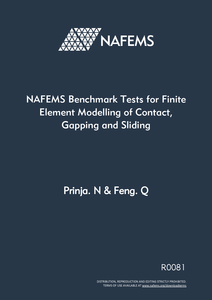| Figure 1 | Contact patch test (CGS - 1) |
| Figure 2 | Results of contact pressure for regular mesh model 1 (CGS - 1) |
| Figure 3 | Results of contact pressure for regular mesh model 2 (CGS - 1) |
| Figure 4 | Results of contact pressure for irregular mesh models 3 and 4 (CGS - 1) |
| Figure 5 | Rigid punch on a deformable foundation (CGS - 2) |
| Figure 6 | FE model and results of contact pressures (CGS - 2) |
| Figure 7 | Hertzian contact (CGS - 3) |
| Figure 8 | FE model and contact pressures (CGS - 3) |
| Figure 9 | Sliding wedge with linear springs (CGS - 4) |
| Figure 10 | FE model and horizontal displacements (CGS - 4) |
| Figure 11 | Cantilevered beam loaded against a rigid curvilinear surface (CGS - 5) |
| Figure 12 | FE model and deflections at free end of the cantilever beam (CGS - 5) |
| Figure 13 | Bending of a plate over a stiff cylinder (CGS - 6) |
| Figure 14 | FE model and contact pressure (CGS - 6) |
| Figure 15 | Sliding and rolling of a ring on a rigid surface (CGS - 7) |
| Figure 16 | FE model and displacements for a fine mesh model (CGS - 7) |
| Figure 17 | FE model and displacements for a coarse mesh model (CGS - 7) |
| Figure 18 | Two contacting rings (CGS - 8) |
| Figure 19 | FE model and climbing distances (CGS - 8) |
| Figure 20 | Buckling of a curved column with self-contact (CGS - 9) |
| Figure 21 | FE model and reaction forces against vertical displacement at top (CGS - 9) |
| Figure 22 | Interference between two cylinders (CGS - 10) |
| Figure 23 | FE model and contact pressures between external and internal cylinders (CGS - 10) |



